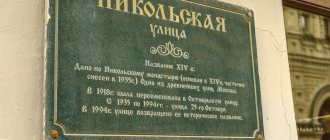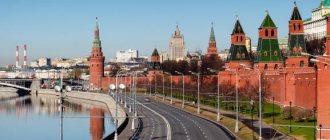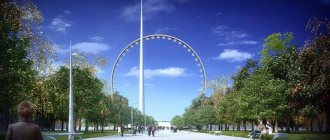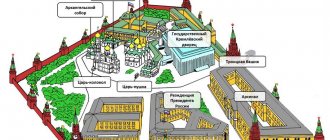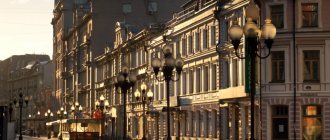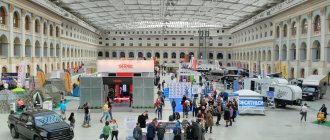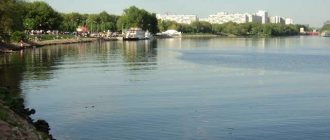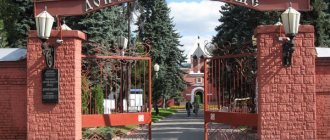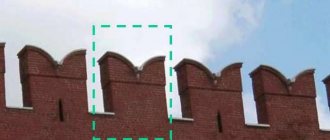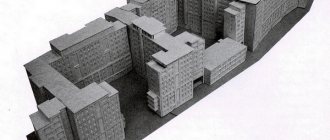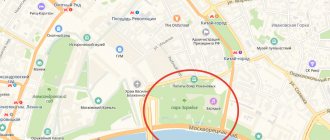Enlarge map
Museum address
st. Varvarka, 4A, Moscow, Zaryadye Park
Operating mode
- Monday Closed
- Tuesday 10:00–20:00
- Wednesday 10:00–20:00
- Thursday 10:00–20:00
- Friday 10:00–20:00
- Saturday 10:00–20:00
- Sunday 10:00–20:00
Ticket price
Tickets 200 rub. Discount 100 rub.
Official site
Phone number
+74955310500
The Old English Court is an architectural and historical landmark of Moscow.
History of the construction of chambers
Snow-white stone buildings were erected in the 15th century. for Ivan Dmitrievich Bobrishchev, who occupies the position of bed guard at the royal court. The chambers were built on Varvarka, a district of Zaryadye inhabited by wealthy merchants, next to 3 churches: St. Barbara, Boris and Gleb, and the Myrrh-Bearing Women. According to scientists, architects from Russia, Italy and England took part in the construction of the building under the leadership of architect Aleviz Fryazin.
Bobrishchev participated in the construction of the Kremlin in Vologda, and then Kitay-Gorod in Moscow, and is considered one of the founders of the stone chambers in Zaryadye. After his death, the buildings came into the possession of the Moscow treasury due to the lack of direct heirs.
In the middle of the 16th century. At the invitation of Tsar Ivan IV (the Terrible), Sir Chancellor, the trade representative of the King of England, arrived in Moscow. In 1555, with the permission of the tsar, for political and trade relations, the first official foreign representative office in Moscow was located in the building on Varvarka - the residence of the English joint-stock trading company.
Subsequently, Ivan the Terrible, in order to strengthen trade with English merchants, gave the British great benefits and privileges for the import of cloth, weapons, gunpowder, and tin utensils into Russia. At the same time, the Moscow trading company opened its activities in London, supplying hemp and wood, wax, leather and furs from Russia.
The buildings were erected for Ivan Dmitrievich Bobrishchev.
Development of the English Court
The merchant's house on Varvarka combined both state rooms and warehouses for storing goods. Moreover, access to the utility rooms in the attic was carried out in an original way - through a window on the southern facade, to which various goods were lifted using a block system. For medieval Moscow, such a device was new.
Representatives of the trading company settled in comfortably - they arranged an English garden with fruit trees around the building, and erected utility rooms. With the permission of the king, a mint was founded to mint coins from imported silver.
After the capital, the English trading company actively opened similar farmsteads in other cities of Russia - in Nizhny and Veliky Novgorod, Vologda, Yaroslavl. Active measures were taken to improve trade, research expeditions were organized to the Russian North and in the eastern direction.
The strengthening of Anglo-Russian ties was also facilitated by several volumes of R. Hakluyt published in London in 1598 with reports on the expeditions in Russia and the stories of their participants. At the beginning of the XVII century. English-Russian dictionaries were published, and books in English appeared in the libraries of Russian boyars.
In 1571, during the invasion of Mongol troops, the building of the courtyard was damaged, but then it was expanded by adding the Cookhouse and the Treasury Chamber.
During the Time of Troubles, the English Trading Company continued its activities, and in 1612 additional extensions were made to the chambers - an internal staircase to the 2nd floor, a vestibule, and the southern facade was decorated anew.
With the expansion of trading activities in Moscow in 1636, the company moved to the New building of the English Court, located on the territory of the White City near the Ilyinsky Gate. After this, the building on Varvarka began to be called the Old English Court.
The merchant's house combines front rooms and warehouses.
However, the political situation changed after the execution of King Charles I of England in 1649. By decree of the Russian Tsar, all British diplomats and trade representatives were expelled from the country, and their property was confiscated. After this, the building came into the possession of boyar Ivan Miloslavsky, one of the royal relatives. At the end of the 17th century. the house was given to the Nizhny Novgorod Metropolitan to establish a metochion.
At the beginning of the 18th century. Tsar Peter I transferred the building to the Arithmetic “Number” School, but after 30 years it became the private property of Moscow merchants. In the XIX century. the chambers were rebuilt, and the façade was decorated in Empire style. In subsequent years, the courtyard was rebuilt many times, and in the 20th century. Apartments and institutions were built here, as a result of which the ancient appearance of the building was practically lost.
English favorites of Ivan the Terrible
Already in 1556, Ivan IV granted the Moscow Joint-Stock Trading Company an empty merchant estate in Zaryadye. Thus, the English Court appeared in Moscow. It will be called old later, when in 1636 the British acquired another one, the New Yard at the Ilyinsky Gate - in the area of the modern Polytechnic Museum.
Then the house was completed spontaneously, without a plan, now it consists of two volumes fused with each other. The building has the main chambers - the government chamber and the kitchen, as well as a basement, attic, staircases, vestibule and porch. This layout of the building finally took shape after the fire of the Time of Troubles, when the courtyard caught fire during an artillery shelling of Kitay-Gorod in 1612. What makes the building of the Old English Court unique is the device for lifting goods into the attic with a double-leaf hatch on the southern facade - completely common in Western European architecture, it was a novelty in medieval Moscow.
Photo: mos.ru
During late excavations at the western facade, archaeologists received a rare piece of luck - a complete set of 16th-century stove tiles with plant and animal ornaments, which made it possible to completely restore the stove in the government chamber. The remains of Russian wall chests with wooden lids were also restored, and the rosette of the vaults was reconstructed according to a model similar in time to the Aleksandrovskaya Sloboda.
Photo: mos.ru
Photo: mos.ru
Photo: mos.ru
The only known schematic representation of the courtyard appeared on one of the earliest plans of Moscow - the so-called Petrov's drawing, published in Amsterdam at the beginning of the 17th century with a legend (explanations) in Latin. On it the property is marked as Aula Anglorum Moskuae negotiantium - “the courtyard of English merchants in Moscow.”
The British brought to Moscow cloth and weapons, gunpowder, saltpeter, sulfur, copper, lead, tin and other components of ammunition necessary for Ivan VI, who led continuous wars. And the great English fleet grew up on Russian raw materials - ship timber, canvas, hemp. The latter was of such high quality that the Moscow Joint Stock Trading Company soon sent seven ropemakers to organize local production for the needs of the English fleet, which for a long time began to be equipped with Russian rigging.
Wax, lard, butter, honey, caviar, flax, and furs were also in great demand in England. With the light hand of the British, the fashion for muscovite, or Muscovite glass, that is, mica, spread across Europe. It was cheaper and more impact-resistant than the glass of that time, which made it possible to insert it into the windows of horse-drawn carriages and portable lanterns.
More than a dozen references to Muscovites, or Russians, noted in the works of William Shakespeare, a contemporary of the formation of Russian-English relations, can be considered evidence of interest in a distant country. They can be found in Love's Labour's Lost, Measure for Measure, Henry V, Macbeth, and The Winter's Tale.
The British established trading settlements in Moscow, Kholmogory, Vologda, Yaroslavl and other cities, and these representations, being assigned to the oprichnina, were under the tutelage of the tsar. With his permission, the British traveled along the Volga to Persia. They were also allowed to search for iron ore on the Vychegda River and mint Russian coins from their silver in Moscow, since local residents were distrustful of foreign money.
The Russian Tsar tried to achieve a military and diplomatic alliance from Queen Elizabeth I, who sat on the English throne, but did not succeed. Ivan the Terrible also showed a desire to become related to the royal house of Tudor, which caused discontent among the Russian boyars (and, according to one hypothesis, led the autocrat to violent death in 1584). When the English envoy who lived in Moscow came to the court, having learned about the death of the sovereign, he was greeted with the words: “Your English king has died!”
Fyodor Ioannovich, the successor of Ivan the Terrible, did not favor the British and soon deprived them of the privileges granted by their father. Relations between the two nations improved again under Boris Godunov, known as the caresser of the British. Mutually beneficial Russian-English ties continued until 1649, when Moscow was shocked by the news that King Charles I Stuart had been executed in revolutionary England.
“And now our Great Sovereign, His Royal Majesty, knows that the British have committed a great evil deed throughout the entire land, they killed their sovereign Charles the King to death, and for such an evil deed you did not have the chance to be in the Moscow State,” with these words the Tsar Alexey Mikhailovich expelled the British from the country and deprived the trading company of all its possessions, including the Old English Court in Zaryadye.
Photo: mos.ru
Architecture and interiors of chambers
The old building of the English courtyard of the 16th century. was found by accident. It was discovered under earthen layers by the scientist P. Baranovsky in the 1960s, when houses on the territory of Zaryadye were demolished for the construction of the Rossiya Hotel and an underground overpass. The restorer was able to defend the monument of architecture, culture and history of Moscow.
In 1968-1972. a reconstruction of the old appearance of the stone chambers was carried out according to the plan of architects I.I. Kazakevich and E.P. Zhavoronkov, during which it was even necessary to use sappers to free the old walls from many years of deposits. During the restoration of buildings, builders were able to restore the stonework of the walls, window and door openings. However, many decorative elements were lost, so they were replaced with later fragments of the reconstruction. Thus, the wide windows on the east side date back to the 18th century.
The facades from the north, west and east have a laconic appearance: snow-white walls with window openings of the 16th-18th centuries. On the southern front side of the building, facing the Moscow River, the walls are decorated with cornices, blades and belts.
The main premises of the Old English Court in Moscow are the Treasury Chamber and the Povarnya (kitchen).
Two large rooms are located upstairs in the white stone rooms and date from the 16th-17th centuries. In addition, the building has an attic, basement, vestibule, stairs and porch.
Treasury Chamber
The government chamber was used as a state hall, and a wide staircase leads to it.
The Treasury Chamber is the provincial hall of the Ministry of Finance.
The floor is paved with “checkerboard” black and white tiles; in the center there is a long wooden table with chairs. In the corner there is an old stove lined with red tiles (discovered during excavations of the courtyard). The ceiling of the building is a snow-white brick vault, in the center of which consoles are assembled into a rosette, to which a carob chandelier is attached.
The chamber hosted business meetings and ceremonial receptions of representatives of the Moscow company, and housed the merchant treasury.
Cook
The Cookhouse building was added after the fire of 1571 and has wide east windows (dated to the 18th century). Adjacent to it is a vestibule, to which a staircase leads from the porch. The kitchen was built here under the merchant Miloslavsky.
Below there is a large basement - a basement with a barrel-shaped vault resting on 2-meter walls made of white stone. Previously, it was used to store goods delivered through the loading hatch. The depth of the room protected the warehouses well from temperature changes outside, as well as from fires. There were small windows in the walls, and “pechurs”—small niches—were used as cabinets. Ancient steps of varying heights lead to the basement.
Luxury real estate in medieval Moscow
The first owner of the farmstead with a remarkable stone structure was a wealthy merchant Ivan Dmitrievich Bobrishchev.
Little remains of his house, built in the 1510s: a white stone basement with barrel vaults - the oldest part of the Old English Court, as well as the upper chambers, which were later rebuilt. In Moscow at that time, civil stone buildings were very expensive and therefore rare. Of the earlier analogues, only the Faceted Chamber in the Kremlin (late 15th century) and the neighboring chambers of the Romanov boyars on Varvarka (the turn of the 15th–16th centuries) have survived to this day.
Little is known about Bobrishchev himself. It is believed that he came from a merchant family that became rich in trade with the city of Surozh (now Sudak), which was a prominent commercial center of the Genoese Republic in Crimea. The neighboring churches of the Holy Great Martyr Varvara and St. Maxim the Blessed were built with contributions from Bobrishchev’s comrades in the craft, guests from Surodzhan, who also owned land on Varvarka.
Photo: mos.ru
“And all those churches had master Aleviz Fryazin,” reports the chronicle for 1514. Aleviz Fryazin, or Aleviz the New, is one of the famous Italian architects who arrived in Rus' at the invitation of Ivan III. By the way, the arrival of foreign masters coincides with the appearance in the Russian language of the word “chambers”, derived either from the Latin palatium, or from the Italian palazzo, which means “palace”.
Bobrishchev's ownership was not limited to one stone building for storing valuables and goods. It also included wooden residential and outbuildings, and an orchard extended towards the river. The choice of location suggests that the first owner of the property belonged to the trading elite. Only an extremely wealthy Muscovite could afford to settle, on the one hand, next to the Kremlin and Red Square, which by that time had taken shape as the Great Market, and on the other hand, next to the pier on the Moscow River, which was used for transporting goods by water or ice .
How the story of the wealthy merchant ended is unknown. He probably had no heirs. The next time “the building of Ivan Bobrishchev’s guest” appears in written sources is in the 1550s and is already listed in the royal treasury.
Photo: mos.ru
Photo: mos.ru
Photo: mos.ru
Photo: mos.ru
Photo: mos.ru
Museum in Moscow
In 1994, the grand opening of the Museum of the English Metochion took place as a branch of the Moscow Museum Complex. The ceremony was attended by Queen Elizabeth II of England and her husband, who were on an official visit to the Russian capital these days.
Permanent exhibition
In the snow-white building of the museum complex, many antique products are exhibited, which, with the help of an interactive exhibition, allow you to examine the furnishings of an old merchant's house.
The museum has many antique items that help to see the surroundings.
In the Treasury Chamber you can see:
- pieces of antique furniture (table, chairs, chests, etc.);
- on the windows there are maps and books brought from England;
- ancient tiles found during excavations of the courtyard.
In the exposition of the Povarna premises you can see display cases with archaeological finds, ancient dishes and kitchen utensils of the 16th-18th centuries.
Notable Items
The theme of the excursion around the territory of the Old English Metochion includes a story about trade and diplomatic relations between England and Russia in the 16th-17th centuries. and inspection of the building. It allows you to see the interior decoration and architectural splendor of an ancient building in one of the old districts of Moscow.
In the front room of the building - the Treasury Chamber - performances of ancient music ensembles are regularly held.
Excursion service
In 2021, excursions around the English Court are carried out every half hour and allow you to view the updated exhibition of the museum.
Information for visitors
Inspection of the buildings of the Old English Compound is included in the permanent historical route through Zaryadye Park. You can go through it either independently, purchasing an audio guide at the ticket office, or with a guide.
Rules for visiting the English courtyard
To increase the safety of visitors, it is allowed to form a tour group of no more than 10 people. Pedestrian inspection of the surrounding area is possible in groups of up to 15 people.
To increase safety, small excursion groups are formed.
Children's classes in the Arithmetic School and the Navigation Room will be held according to the same rules - according to the schedule. This fall it is also planned to hold the Olympiad “Museums. Parks. Estates."
Schedule and work schedule
The museum is open to visitors on weekdays and weekends - from Tuesday to Sunday. Opening hours: 10.00 - 20.00. On Monday, the Old English Court is closed for sanitization.
Address and location on the map
The estate of the Old English Compound is located at the address: Moscow, st. Varvarka, 4A and is located on the territory of the Zaryadye complex, which can be seen on the map below.
Ticket prices and preferential service
Tickets are sold on the website, in a special mobile application and in the terminals of Zaryadye Park, at the ticket office of the museum, the Reserve Embassy and the Media Center, and in the souvenir shop.
Ticket price is 200 rubles, for a preferential category of visitors - 100 rubles.
The Old English Courtyard became part of Zaryadye Park
Text author: Alisa TITKO
They decided to include the Old English Courtyard in the landscape and architectural complex of Zaryadye Park. The building, which is more than 500 years old, will complement the map of excursion routes and present visitors with a collection of archaeological finds that were made in the Zaryadye and Kitai-Gorod districts. The first excursions will take place on City Day, September 5 and 6, and will be free.
The time machine will take you to the 16th century chambers
- Be careful, low doorways. Look under your feet - in front of you are some of the oldest steps in Moscow. “You are on the threshold of the first official representative office of a foreign power that has survived in Moscow,” says Alexander Sotin, leading manager of the museum activities department of Zaryadye Park.
Photo: Mikhail Frolov
The chambers on Varvarka Street were built at the beginning of the 16th century. It is not known exactly when. Initially, merchant Ivan Bobrishchev lived here, and then merchants from London lived here. Since 1556, the residence of the English trading Moscow company was located in the courtyard. And the chambers turned into an office with warehouse space, as they would say now. The British brought cloth, ammunition, non-ferrous metals, and luxury goods here for sale. And wax, ropes for ships, mica, honey and caviar were exported from Russia. This is how Russian-English trade relations were built during the reign of Tsar Ivan the Terrible and Queen Elizabeth I.
— The Muscovites from a distant, huge power became reliable partners for the British. We got to Moscow via the Volga and Yaroslavl. In those days, Ivan the Terrible took Kazan, and then Astrakhan. Thus, the path along the Volga to the lands of India and China opened. Both England and Russia were then in trade isolation, and for them it was an extremely profitable relationship. In Russia, Peter I would build a fleet in another 150 years, and the British were just beginning to build ships for long-distance expeditions, and therefore these mutual contacts turned out to be a great experience for both countries, says Alexander Sotin.
And this one-story building on Varvarka was offered to the British as an “office.” It had a meeting room and a kitchen, and goods from England were stored in the basement.
Now you can see that very atmosphere of the 16th century thanks to the recreated tables, benches, and Russian stove. In fact, this is the oldest business office that has survived in Moscow to this day.
Photo: Mikhail Frolov
— We added presentations that allow us to understand what the people sitting at these tables thought about Russia. These are quotes from the diaries of foreign ambassadors and travelers, merchants and scientists who stayed in this courtyard, says Alexander Sotin.
The museum expanded the history of the Old English Court to the history of China Town. After all, the building did not live in isolation; there were residential buildings around it. Visitors will also be able to see in the museum unique finds that were discovered during archaeological excavations and construction of the park on the territory of the oldest districts of Moscow - Zaryadye and Kitai-Gorod.
— We have added multimedia activities, you can “talk” with a merchant and a warrior of those times. A new archaeological exhibition has appeared; three treasures with coins and jugs were found on the territory of Zaryadye. These are things from the 15th-17th centuries,” says Evgeny Avdeenko, curator of the museum’s representative office, department of exhibition projects at Zaryadye Park.
Photo: Mikhail Frolov
Among the unusual finds are musket bullets, stone shooting balls, and 16th-century jugs. Visitors will also have access to games and a 10-minute film that will tell the entire history of Zaryadye - from the 12th century to the present day.
INTERESTING TO KNOW
Queen Elizabeth II of Great Britain visited the museum
The old English court may not have survived to this day. After the British left Zaryadye, an arithmetic school was opened in the building; during the reign of Nicholas II, there was the headquarters of a Russian-American company that manufactured tires for cars. During the Soviet years, the building housed a library of foreign literature. During the construction of the Russia Hotel, they wanted to demolish it altogether, but they preserved it, restored it, and in 1994 they opened a museum, the opening of which was attended by Queen Elizabeth II of Great Britain.
In the plans
“In the intimate spaces of the Old English Court, we will be able to embody ideas in contrasting eras, actively using multimedia technologies, including projections on the walls, light and sound design, which will enhance the perception of the existing exhibition. And the centuries-old history of the building, associated with the Zaryadye district, will make it easy to fit the museum into excursion routes and the park’s event program,” said Ivan Demidov, director of Zaryadye Park.
Photo: Mikhail Frolov
How to get on the excursion:
— planned to be carried out every 30 minutes,
— groups of no more than 10 people,
— you can take an excursion in the company of a guide or on your own,
— Navigation and arithmetic schools will open their doors for children, classes will be held from Tuesday to Friday as scheduled.
Where: Varvarka, 6. Nearest metro station “Kitay Gorod”.
When: Tuesday to Sunday from 10.00 to 20.00 (Monday is a sanitary day). The ticket office closes at 6:45 p.m.
Prices: adult ticket - 300 rubles, children's ticket (from 7 years to 18 years) - 150 rubles, for full-time students - 150 rubles. Tickets are available at the Old English Court box office or the Media Center pavilion.
Photo: Mikhail Frolov
Feedback from visitors to the English Court
Maria, 35 years old, Vologda: “I was with my husband on an excursion to Zaryadye, looked at the house of the Old Yard of the English Trading Company and was pleasantly surprised. We listened to an interesting story about diplomatic relations and the development of trade in the 17th-18th centuries. between Great Britain and Russia. We looked around the cozy snow-white mansion and were shown a film about its history and architecture. I recommend everyone to go to the museum and for 200 rubles. Plunge into Moscow's past."
Sergey, 42 years old, Omsk: “The Museum of the English Compound allowed us to see how people lived in medieval Rus' - both Russians and English. The building is one of the few that have survived over the 400-year period. There are many interesting exhibits, ancient books, dishes and furniture, a beautiful large stove decorated with original tiles found during excavations. I received a charge of positivity."
